Research on the Design Parameters of Outdoor Transitional Spaces Based on the Improvement of Thermal Environment
Abstract
1. Introduction
2. Background Study
2.1. Studies About Effects of Design Parameters of Transitional Spaces on Microclimate Under Different Climate Zones
2.1.1. Studies About Effects of Orientations of Transitional Spaces on Microclimate
2.1.2. Studies About Effects of Aspect Ratio and Plan Aspect Ratio of Transitional Spaces on Microclimate
2.1.3. Studies About Effects of Enclosing Degree of Transitional Spaces on Microclimate
2.2. Summary of Background Information
3. Methodology
3.1. Study Areas
3.2. Physical Measurement
3.3. Simulation
4. Results
4.1. Field Experiment Results
4.2. Numerical Simulation
4.2.1. Establishment of Measuring Site Model
4.2.2. Simulation Parameter Setting
4.2.3. Validation of the Numerical Results
4.2.4. Analysis of Thermal Environment at Measuring Sites
4.2.5. Existing Problems and Optimization Points of the Thermal Environment in the Study Sites
4.3. Performance Simulation of Outdoor Transitional Space with Different Parameters
4.3.1. Orientation
4.3.2. Aspect Ratio
4.3.3. Length-to-Width Ratio
4.3.4. Enclosing Degree
5. Discussion
6. Conclusions
Author Contributions
Funding
Data Availability Statement
Conflicts of Interest
Nomenclature
| OTC | Outdoor thermal comfort |
| SVF | Sky view factor |
| Ta | Air temperature (°C) |
| Tg | Globe temperature (°C) |
| RH | Relative humidity (%) |
| Va | Wind speed (m/s) |
| Tmrt | Mean radiant temperature (°C) |
| W | Width |
| H | Height |
| L | Length |
| AR, H/W | Aspect ratio, Height-to-width ratio |
| L/W | Length-width ratio |
References
- Ritchie, H.; Samborska, V.; Roser, M. Urbanization; Our World in Data: Oxford, UK, 2024. [Google Scholar]
- Guan, X.; Wei, H.; Lu, S.; Dai, Q.; Su, H. Assessment on the urbanization strategy in China: Achievements, challenges and reflections. Habitat Int. 2018, 71, 97–109. [Google Scholar] [CrossRef]
- Van Hove, L.; Jacobs, C.; Heusinkveld, B.; Elbers, J.; Van Driel, B.; Holtslag, A. Temporal and spatial variability of urban heat island and thermal comfort within the Rotterdam agglomeration. Build. Environ. 2015, 83, 91–103. [Google Scholar] [CrossRef]
- Morris, K.I.; Chan, A.; Morris, K.J.K.; Ooi, M.C.; Oozeer, M.Y.; Abakr, Y.A.; Nadzir, M.S.M.; Mohammed, I.Y.; Al-Qrimli, H.F. Impact of urbanization level on the interactions of urban area, the urban climate, and human thermal comfort. Appl. Geogr. 2017, 79, 50–72. [Google Scholar] [CrossRef]
- Mahmoud, S.H.; Gan, T.Y. Long-term impact of rapid urbanization on urban climate and human thermal comfort in hot-arid environment. Build. Environ. 2018, 142, 83–100. [Google Scholar] [CrossRef]
- Ren, Z.; Fu, Y.; Dong, Y.; Zhang, P.; He, X. Rapid urbanization and climate change significantly contribute to worsening urban human thermal comfort: A national 183-city, 26-year study in China. Urban Clim. 2022, 43, 101154. [Google Scholar] [CrossRef]
- Wong, S.-K.; Lai, L.W.-C.; Ho, D.C.-W.; Chau, K.-W.; Lam, C.L.-K.; Ng, C.H.-F. Sick building syndrome and perceived indoor environmental quality: A survey of apartment buildings in Hong Kong. Habitat Int. 2009, 33, 463–471. [Google Scholar] [CrossRef]
- Hwang, R.-L.; Lin, C.-Y.; Huang, K.-T. Spatial and temporal analysis of urban heat island and global warming on residential thermal comfort and cooling energy in Taiwan. Energy Build. 2017, 152, 804–812. [Google Scholar] [CrossRef]
- Giridharan, R.; Emmanuel, R. The impact of urban compactness, comfort strategies and energy consumption on tropical urban heat island intensity: A review. Sustain. Cities Soc. 2018, 40, 677–687. [Google Scholar] [CrossRef]
- Lai, D.; Guo, D.; Hou, Y.; Lin, C.; Chen, Q. Studies of outdoor thermal comfort in northern China. Build. Environ. 2014, 77, 110–118. [Google Scholar] [CrossRef]
- Martinelli, L.; Lin, T.-P.; Matzarakis, A. Assessment of the influence of daily shadings pattern on human thermal comfort and attendance in Rome during summer period. Build. Environ. 2015, 92, 30–38. [Google Scholar] [CrossRef]
- Lai, D.; Liu, W.; Gan, T.; Liu, K.; Chen, Q. A review of mitigating strategies to improve the thermal environment and thermal comfort in urban outdoor spaces. Sci. Total Environ. 2019, 661, 337–353. [Google Scholar] [CrossRef] [PubMed]
- Manavvi, S.; Rajasekar, E. Evaluating outdoor thermal comfort in urban open spaces in a humid subtropical climate: Chandigarh, India. Build. Environ. 2022, 209, 108659. [Google Scholar] [CrossRef]
- Jusuf, S.K.; Wong, N.H.; Hagen, E.; Anggoro, R.; Hong, Y. The influence of land use on the urban heat island in Singapore. Habitat Int. 2007, 31, 232–242. [Google Scholar] [CrossRef]
- Li, J.; Song, C.; Cao, L.; Zhu, F.; Meng, X.; Wu, J. Impacts of landscape structure on surface urban heat islands: A case study of Shanghai, China. Remote Sens. Environ. 2011, 115, 3249–3263. [Google Scholar] [CrossRef]
- Lin, P.; Lau, S.S.Y.; Qin, H.; Gou, Z. Effects of urban planning indicators on urban heat island: A case study of pocket parks in high-rise high-density environment. Landsc. Urban Plan. 2017, 168, 48–60. [Google Scholar] [CrossRef]
- Huang, S.-C.L. A study of outdoor interactional spaces in high-rise housing. Landsc. Urban Plan. 2006, 78, 193–204. [Google Scholar] [CrossRef]
- Lai, D.; Zhou, C.; Huang, J.; Jiang, Y.; Long, Z.; Chen, Q. Outdoor space quality: A field study in an urban residential community in central China. Energy Build. 2014, 68, 713–720. [Google Scholar] [CrossRef]
- Li, K.; Zhang, Y.; Zhao, L. Outdoor thermal comfort and activities in the urban residential community in a humid subtropical area of China. Energy Build. 2016, 133, 498–511. [Google Scholar] [CrossRef]
- Huang, J.; Zhou, C.; Zhuo, Y.; Xu, L.; Jiang, Y. Outdoor thermal environments and activities in open space: An experiment study in humid subtropical climates. Build. Environ. 2016, 103, 238–249. [Google Scholar] [CrossRef]
- Sharifi, E.; Boland, J. Limits of thermal adaptation in cities: Outdoor heat-activity dynamics in Sydney, Melbourne and Adelaide. Archit. Sci. Rev. 2018, 61, 191–201. [Google Scholar] [CrossRef]
- Haowei, P. Research on Public Space Design in Old Communities Based on the Perspective of Micro-Renewal. 2023. Available online: http://pea.lib.pte.hu/handle/pea/34995 (accessed on 13 October 2024).
- Nikolopoulou, M.; Lykoudis, S. Thermal comfort in outdoor urban spaces: Analysis across different European countries. Build. Environ. 2006, 41, 1455–1470. [Google Scholar] [CrossRef]
- Peng, S.; Maing, M. Influential factors of age-friendly neighborhood open space under high-density high-rise housing context in hot weather: A case study of public housing in Hong Kong. Cities 2021, 115, 103231. [Google Scholar] [CrossRef]
- Kwon, C.W.; Lee, K.J. Outdoor thermal comfort in a transitional space of canopy in schools in the UK. Sustainability 2017, 9, 1753. [Google Scholar] [CrossRef]
- Zhang, Y.; Liu, J.; Zheng, Z.; Fang, Z.; Zhang, X.; Gao, Y.; Xie, Y. Analysis of thermal comfort during movement in a semi-open transition space. Energy Build. 2020, 225, 110312. [Google Scholar] [CrossRef]
- Chun, C.; Kwok, A.; Tamura, A. Thermal comfort in transitional spaces—Basic concepts: Literature review and trial measurement. Build. Environ. 2004, 39, 1187–1192. [Google Scholar] [CrossRef]
- Chun, C.; Tamura, A. Thermal comfort in urban transitional spaces. Build. Environ. 2005, 40, 633–639. [Google Scholar] [CrossRef]
- Jiao, Y.; Yu, Y.; Yu, H.; Wang, F. The impact of thermal environment of transition spaces in elderly-care buildings on thermal adaptation and thermal behavior of the elderly. Build. Environ. 2023, 228, 109871. [Google Scholar] [CrossRef]
- Yung, E.H.K.; Wang, S.; Chau, C.-k. Thermal perceptions of the elderly, use patterns and satisfaction with open space. Landsc. Urban Plan. 2019, 185, 44–60. [Google Scholar] [CrossRef]
- Kwon, C.W.; Lee, K.J. Investigation of the environmental performance of a transitional space in a UK nursery school. Int. J. Sustain. Build. Technol. Urban Dev. 2016, 7, 153–164. [Google Scholar] [CrossRef]
- Chang, S.; He, W.; Yan, H.; Yang, L.; Song, C. Influences of vernacular building spaces on human thermal comfort in China’s arid climate areas. Energy Build. 2021, 244, 110978. [Google Scholar] [CrossRef]
- Sözen, İ.; Oral, G.K. Outdoor thermal comfort in urban canyon and courtyard in hot arid climate: A parametric study based on the vernacular settlement of Mardin. Sustain. Cities Soc. 2019, 48, 101398. [Google Scholar] [CrossRef]
- Huang, X.; Qu, C. Research on indoor thermal comfort and age of air in Qilou street shop under mechanical ventilation scheme: A case study of Nanning traditional block in southern China. Sustainability 2021, 13, 4037. [Google Scholar] [CrossRef]
- Juan, Y.-H.; Yang, A.-S.; Wen, C.-Y.; Lee, Y.-T.; Wang, P.-C. Optimization procedures for enhancement of city breathability using arcade design in a realistic high-rise urban area. Build. Environ. 2017, 121, 247–261. [Google Scholar] [CrossRef]
- Huang, X.; Li, C.; Zhuang, Z. Analysis of height-to-width ratio of commercial streets with arcades based on sunshine hours and street orientation. Appl. Sci. 2021, 11, 1706. [Google Scholar] [CrossRef]
- Andreou, E. Thermal comfort in outdoor spaces and urban canyon microclimate. Renew. Energy 2013, 55, 182–188. [Google Scholar] [CrossRef]
- Rodríguez-Algeciras, J.; Tablada, A.; Nouri, A.S.; Matzarakis, A. Assessing the influence of street configurations on human thermal conditions in open balconies in the Mediterranean climate. Urban Clim. 2021, 40, 100975. [Google Scholar] [CrossRef]
- Ali-Toudert, F.; Mayer, H. Numerical study on the effects of aspect ratio and orientation of an urban street canyon on outdoor thermal comfort in hot and dry climate. Build. Environ. 2006, 41, 94–108. [Google Scholar] [CrossRef]
- Ali-Toudert, F.; Mayer, H. Effects of asymmetry, galleries, overhanging facades and vegetation on thermal comfort in urban street canyons. Sol. Energy 2007, 81, 742–754. [Google Scholar] [CrossRef]
- Yin, S.; Lang, W.; Xiao, Y.; Xu, Z. Correlative impact of shading strategies and configurations design on pedestrian-level thermal comfort in traditional shophouse neighbourhoods, Southern China. Sustainability 2019, 11, 1355. [Google Scholar] [CrossRef]
- Chan, A. Investigation on the appropriate floor level of residential building for installing balcony, from a view point of energy and environmental performance. A case study in subtropical Hong Kong. Energy 2015, 85, 620–634. [Google Scholar] [CrossRef]
- Yin, S.; Wang, F.; Xiao, Y.; Xue, S. Comparing cooling efficiency of shading strategies for pedestrian thermal comfort in street canyons of traditional shophouse neighbourhoods in Guangzhou, China. Urban Clim. 2022, 43, 101165. [Google Scholar] [CrossRef]
- Weng, J.; Luo, B.; Xiang, H.; Gao, B. Effects of bottom-overhead design variables on pedestrian-level thermal comfort during summertime in different high-rise residential buildings: A case study in Chongqing, China. Buildings 2022, 12, 265. [Google Scholar] [CrossRef]
- Zhu, J.; Feng, J.; Lu, J.; Chen, Y.; Li, W.; Lian, P.; Zhao, X. A review of the influence of courtyard geometry and orientation on microclimate. Build. Environ. 2023, 236, 110269. [Google Scholar] [CrossRef]
- Savvides, A.; Michael, A.; Malaktou, E.; Philokyprou, M. Examination and assessment of insolation conditions of streetscapes of traditional settlements in the Eastern Mediterranean area. Habitat Int. 2016, 53, 442–452. [Google Scholar] [CrossRef]
- Su, Y.M.; Chang, H.T. Influence of summer outdoor pedestrian wind environment comfort with height-to-width ratios of arcade in Taiwan. Appl. Mech. Mater. 2016, 851, 633–638. [Google Scholar] [CrossRef]
- Hang, J.; Luo, Z.; Sandberg, M.; Gong, J. Natural ventilation assessment in typical open and semi-open urban environments under various wind directions. Build. Environ. 2013, 70, 318–333. [Google Scholar] [CrossRef]
- Kim, T.; Kim, K.; Kim, B.S. A wind tunnel experiment and CFD analysis on airflow performance of enclosed-arcade markets in Korea. Build. Environ. 2010, 45, 1329–1338. [Google Scholar] [CrossRef]
- Yin, S.; Xiao, Y. Scale study of traditional shophouse street in south of China based on outdoor thermal comfort. Procedia Eng. 2016, 169, 232–239. [Google Scholar] [CrossRef]
- Malaktou, E.; Philokyprou, M. Summer thermal comfort conditions in shopping arcades and their adjoining streets in hot and dry climates. The case of the Nicosia’s historic centre. Proc. IOP Conf. Ser. Earth Environ. Sci. 2020, 410, 012093. [Google Scholar] [CrossRef]
- Taleghani, M.; Kleerekoper, L.; Tenpierik, M.; Van Den Dobbelsteen, A. Outdoor thermal comfort within five different urban forms in the Netherlands. Build. Environ. 2015, 83, 65–78. [Google Scholar] [CrossRef]
- Omrani, S.; Garcia-Hansen, V.; Capra, B.; Drogemuller, R. On the effect of provision of balconies on natural ventilation and thermal comfort in high-rise residential buildings. Build. Environ. 2017, 123, 504–516. [Google Scholar] [CrossRef]
- Munawaroh, A.S.; Damayanti, E.; Prasetyo, Y.A. A Field Measurement of Thermal Comfort in Semi Outdoor Space in Hot-Humid Climate. Proc. IOP Conf. Ser. Earth Environ. Sci. 2021, 738, 012066. [Google Scholar] [CrossRef]
- Yilmaz, S.; Külekçi, E.A.; Mutlu, B.E.; Sezen, I. Analysis of winter thermal comfort conditions: Street scenarios using ENVI-met model. Environ. Sci. Pollut. Res. 2021, 28, 63837–63859. [Google Scholar] [CrossRef] [PubMed]
- Yuan, X.; Ryu, Y.; Sekartaji, D. Effect of balcony forms difference on indoor thermal environment and energy saving performance of multiple-dwelling house. Front. Energy Res. 2022, 10, 891946. [Google Scholar] [CrossRef]
- Peel, M.C.; Finlayson, B.L.; McMahon, T.A. Updated world map of the Köppen-Geiger climate classification. Hydrol. Earth Syst. Sci. 2007, 11, 1633–1644. [Google Scholar] [CrossRef]
- Moroşan, P.-D.; Bourdais, R.; Dumur, D.; Buisson, J. Building temperature regulation using a distributed model predictive control. Energy Build. 2010, 42, 1445–1452. [Google Scholar] [CrossRef]
- Álvarez, J.; Redondo, J.L.; Camponogara, E.; Normey-Rico, J.; Berenguel, M.; Ortigosa, P. Optimizing building comfort temperature regulation via model predictive control. Energy Build. 2013, 57, 361–372. [Google Scholar] [CrossRef]
- Zhao, J.-h.; Feng, G.-l.; Zhi, R. Progresses and prospects in research on season division and seasonal changes in China. J. Trop. Meteorol. 2013, 19, 28. [Google Scholar]
- Bruse, M.; Fleer, H. Simulating surface–plant–air interactions inside urban environments with a three dimensional numerical model. Environ. Model. Softw. 1998, 13, 373–384. [Google Scholar] [CrossRef]
- Tsoka, S.; Tsikaloudaki, A.; Theodosiou, T. Analyzing the ENVI-met microclimate model’s performance and assessing cool materials and urban vegetation applications–A review. Sustain. Cities Soc. 2018, 43, 55–76. [Google Scholar] [CrossRef]
- Lai, D.; Chen, B.; Liu, K. Quantification of the influence of thermal comfort and life patterns on outdoor space activities. In Building Simulation; Tsinghua University Press: Beijing, China, 2020. [Google Scholar]
- Liu, K.; Lian, Z.; Dai, X.; Lai, D. Comparing the effects of sun and wind on outdoor thermal comfort: A case study based on longitudinal subject tests in cold climate region. Sci. Total Environ. 2022, 825, 154009. [Google Scholar] [CrossRef] [PubMed]
- Wang, L.; Chen, T.; Yu, Y.; Wang, L.; Zang, H.; Cang, Y.; Zhang, Y.o.; Ma, X. Impacts of Vegetation Ratio, Street Orientation, and Aspect Ratio on Thermal Comfort and Building Carbon Emissions in Cold Zones: A Case Study of Tianjin. Land 2024, 13, 1275. [Google Scholar] [CrossRef]
- Acero, J.A.; Herranz-Pascual, K. A comparison of thermal comfort conditions in four urban spaces by means of measurements and modelling techniques. Build. Environ. 2015, 93, 245–257. [Google Scholar] [CrossRef]
- Du, K.; Ning, J.; Yan, L. How long is the sun duration in a street canyon?—Analysis of the view factors of street canyons. Build. Environ. 2020, 172, 106680. [Google Scholar] [CrossRef]
- Li, G.; Ren, Z.; Zhan, C. Sky View Factor-based correlation of landscape morphology and the thermal environment of street canyons: A case study of Harbin, China. Build. Environ. 2020, 169, 106587. [Google Scholar] [CrossRef]
- Miao, C.; Yu, S.; Hu, Y.; Zhang, H.; He, X.; Chen, W. Review of methods used to estimate the sky view factor in urban street canyons. Build. Environ. 2020, 168, 106497. [Google Scholar] [CrossRef]
- Chan, A.; Chow, T.T. Investigation on energy performance and energy payback period of application of balcony for residential apartment in Hong Kong. Energy Build. 2010, 42, 2400–2405. [Google Scholar] [CrossRef]
- Juan, Y.-H.; Wen, C.-Y.; Li, Z.; Yang, A.-S. A combined framework of integrating optimized half-open spaces into buildings and an application to a realistic case study on urban ventilation and air pollutant dispersion. J. Build. Eng. 2021, 44, 102975. [Google Scholar] [CrossRef]
- Pagliarini, G.; Rainieri, S. Thermal environment characterisation of a glass-covered semi-outdoor space subjected to natural climate mitigation. Energy Build. 2011, 43, 1609–1617. [Google Scholar] [CrossRef]
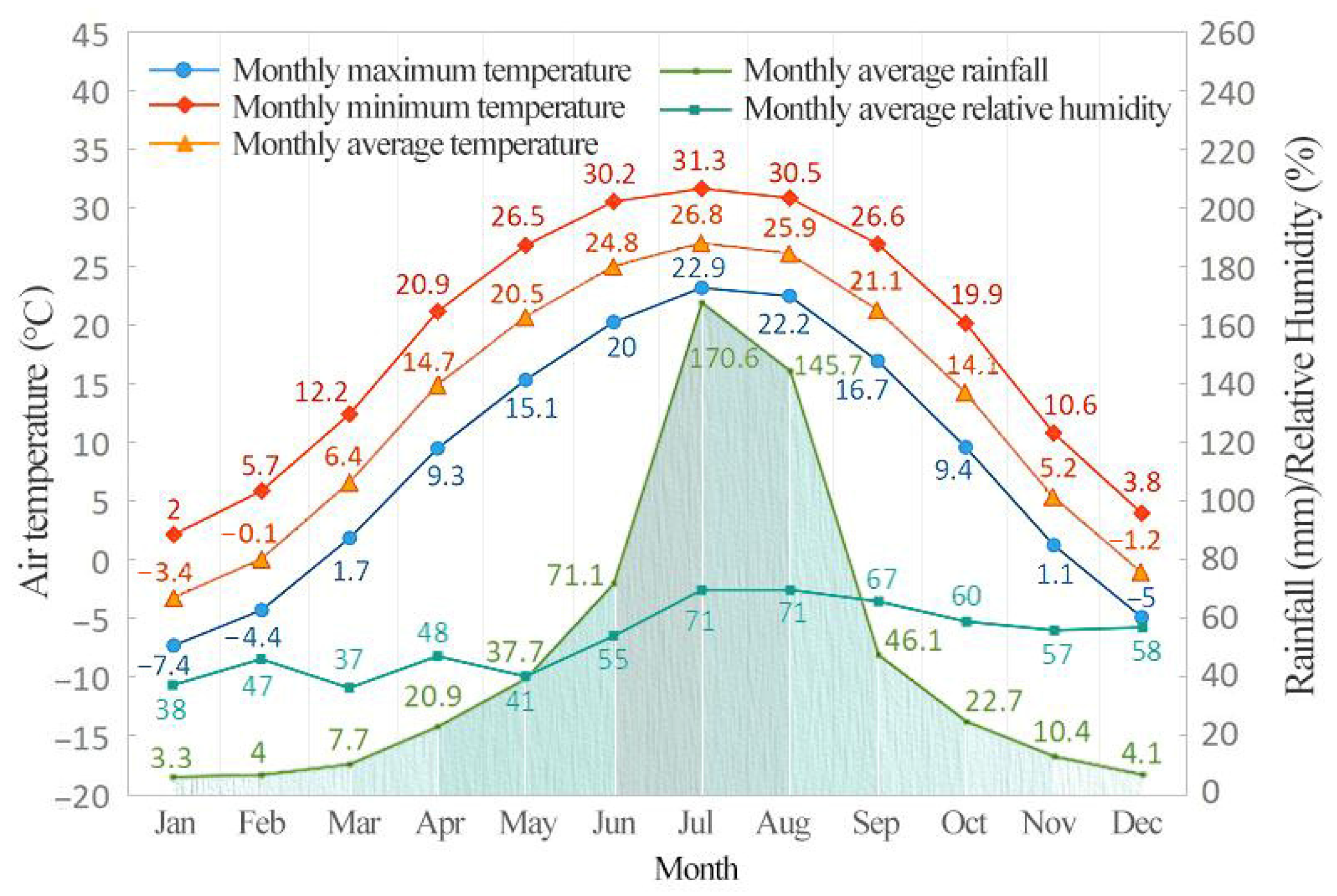
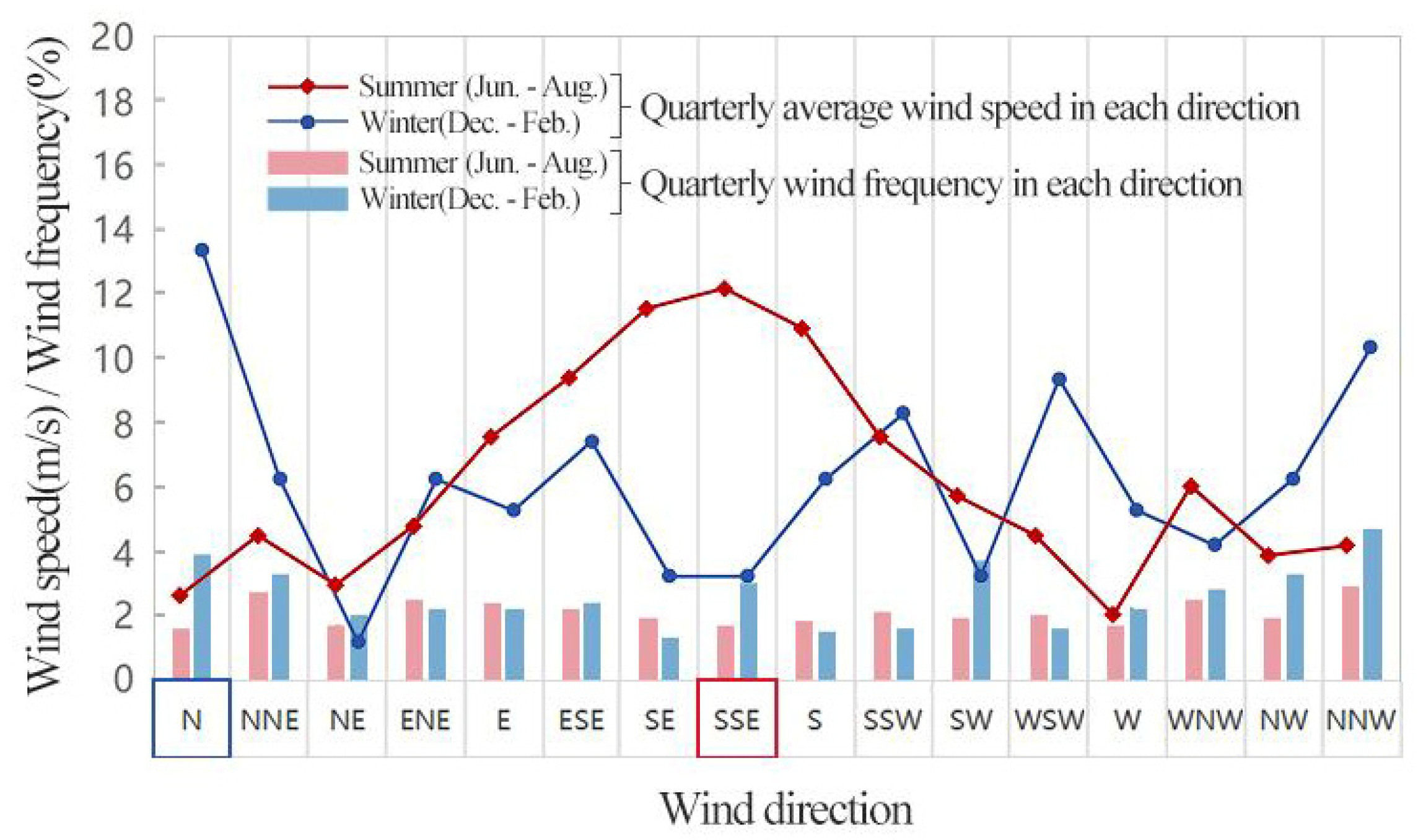
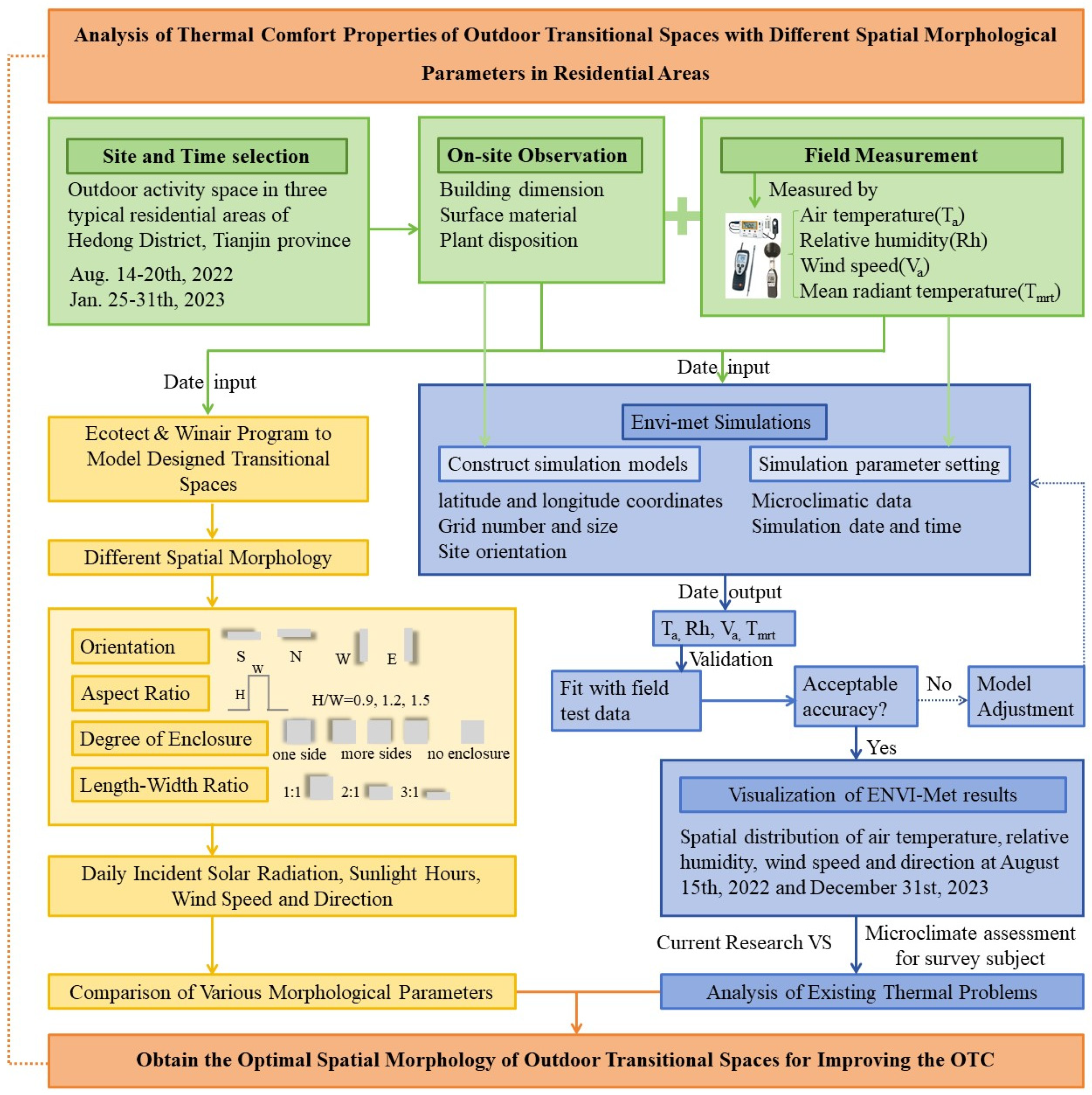

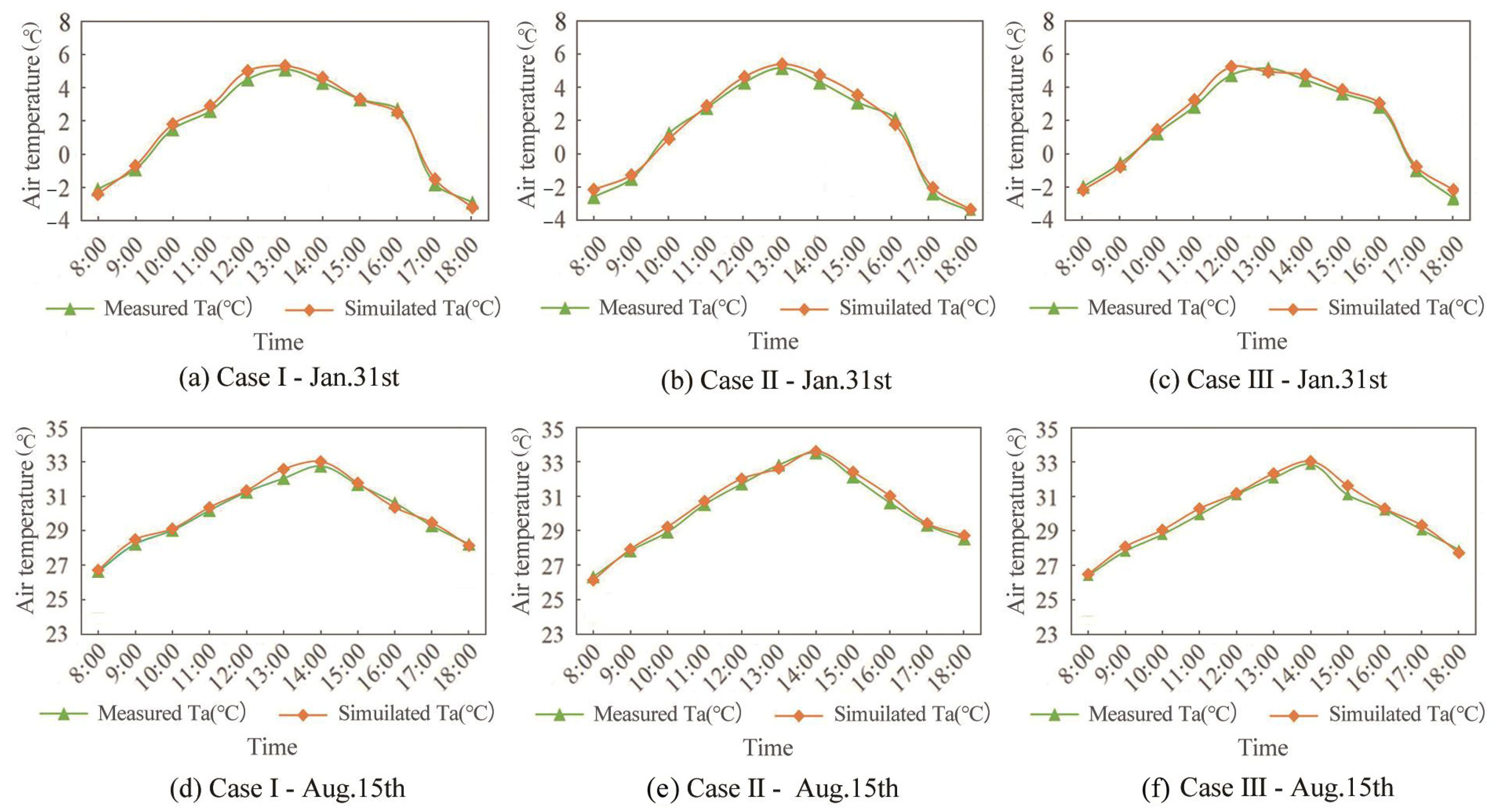
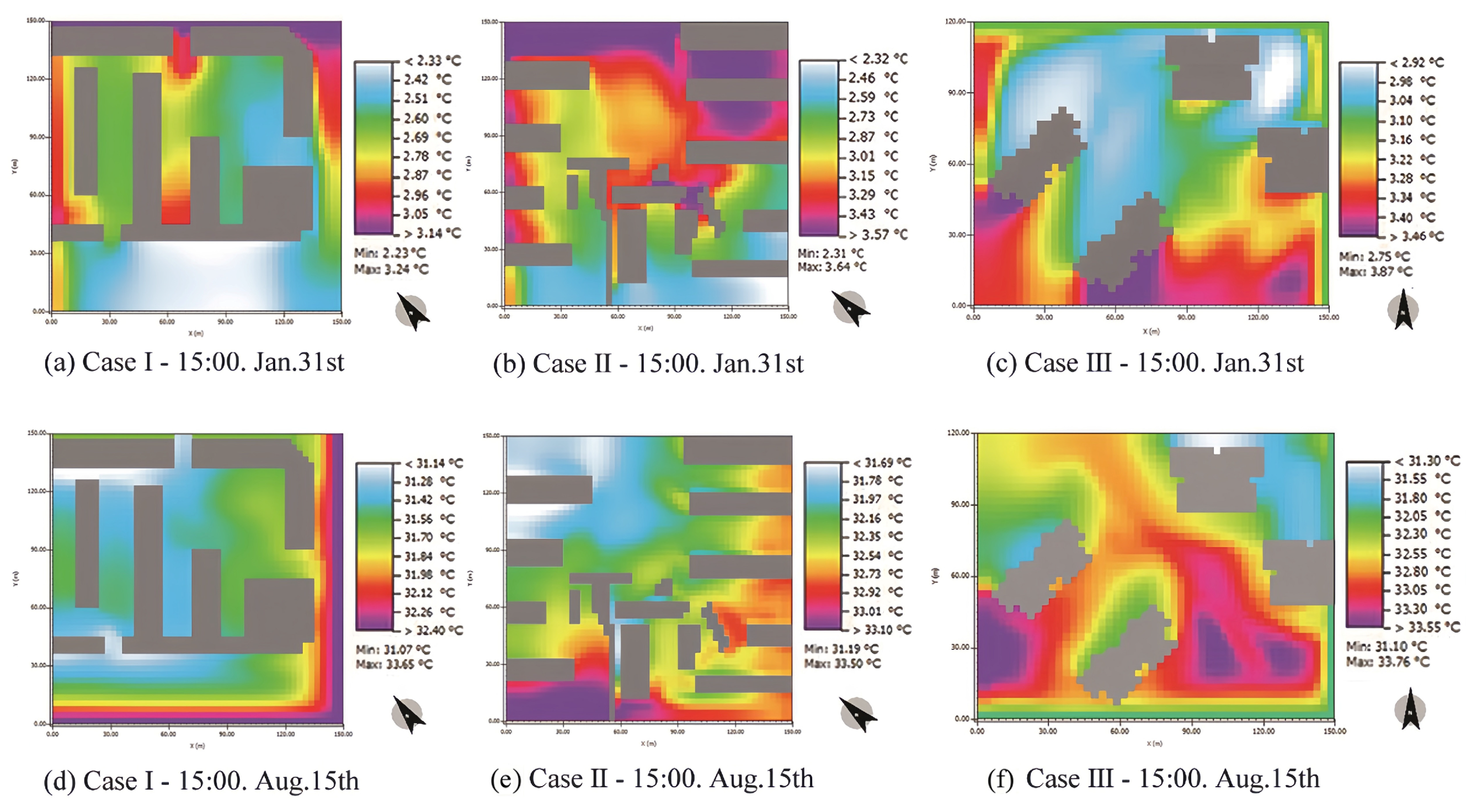
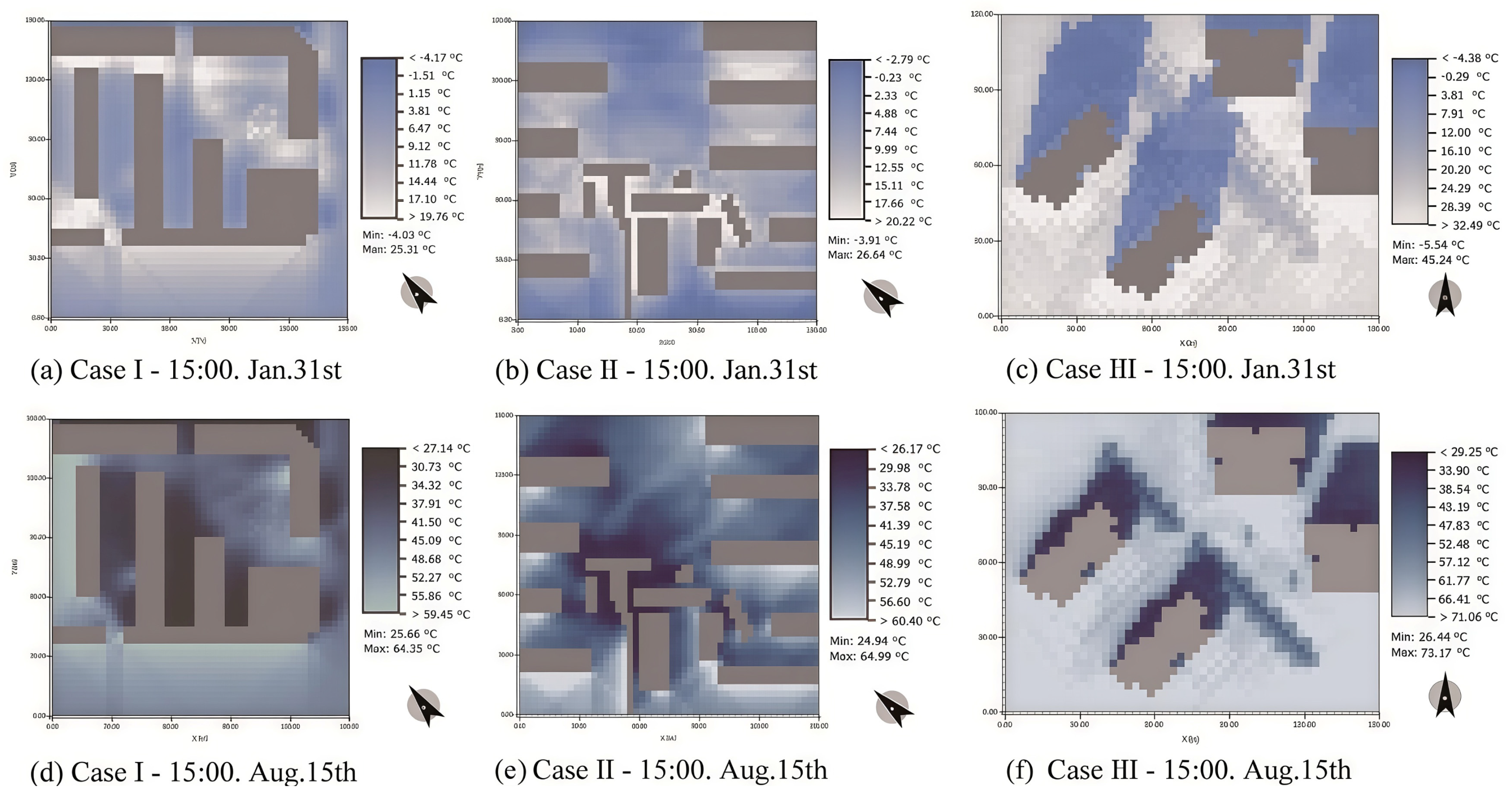
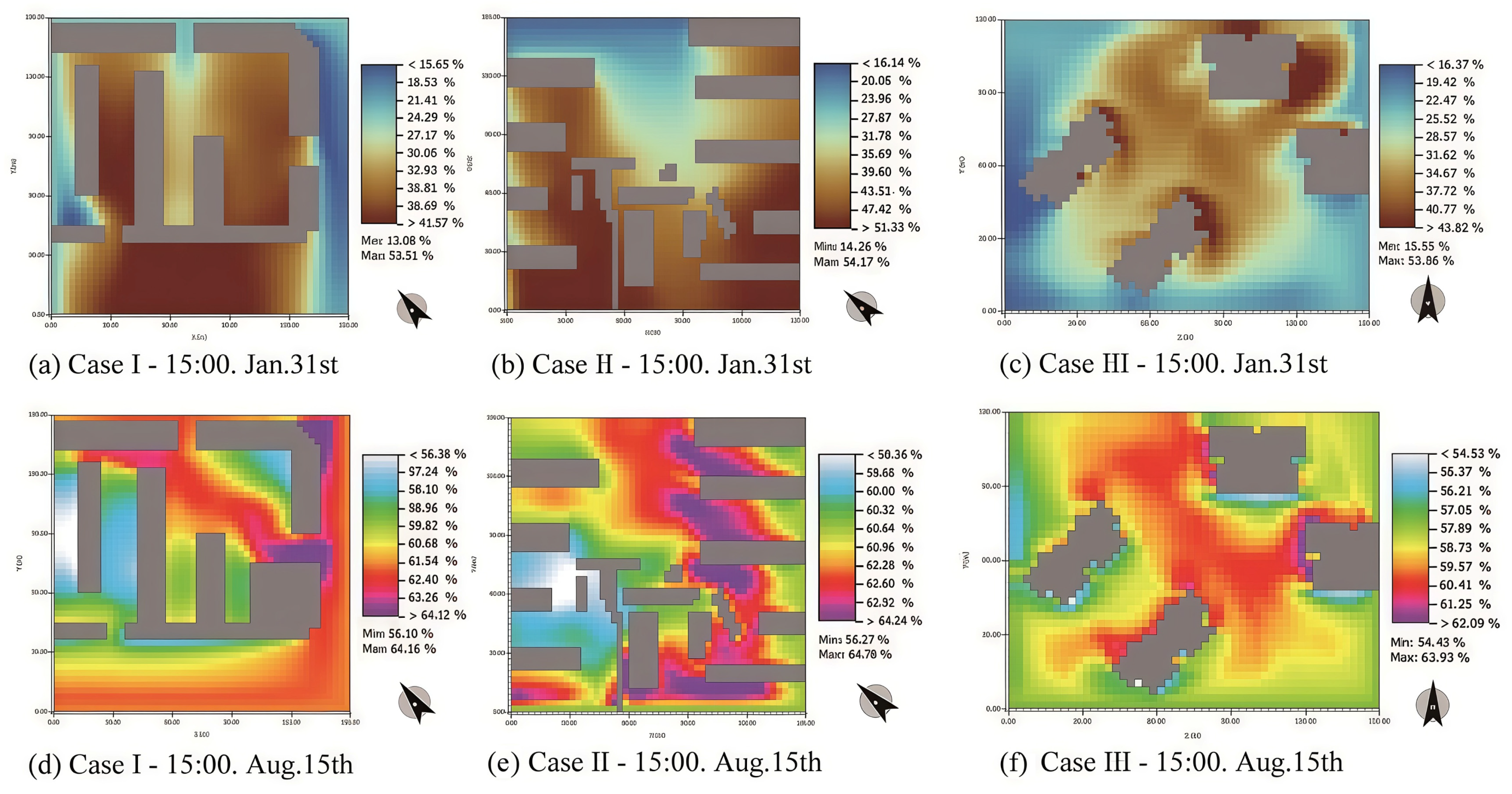
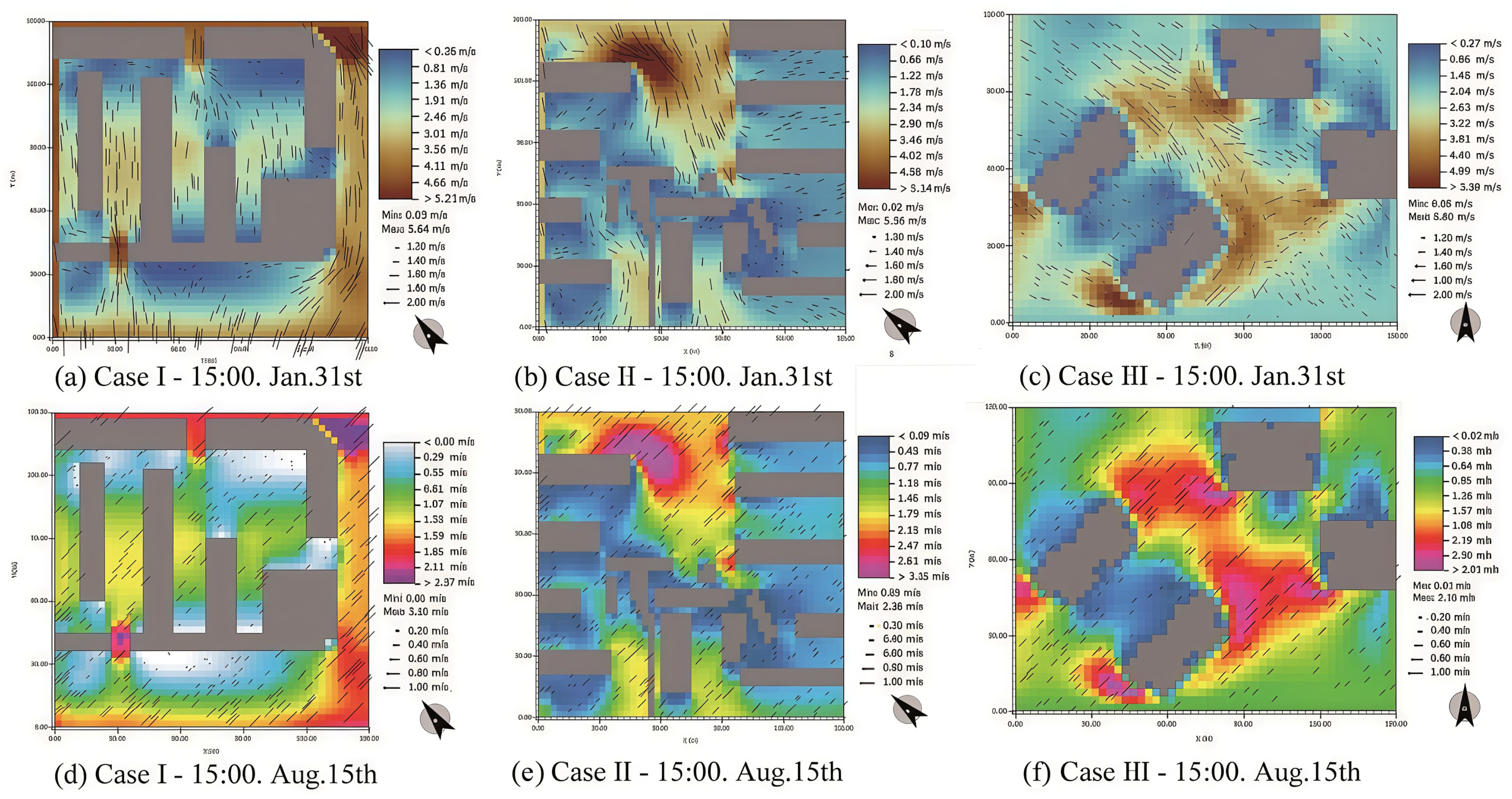
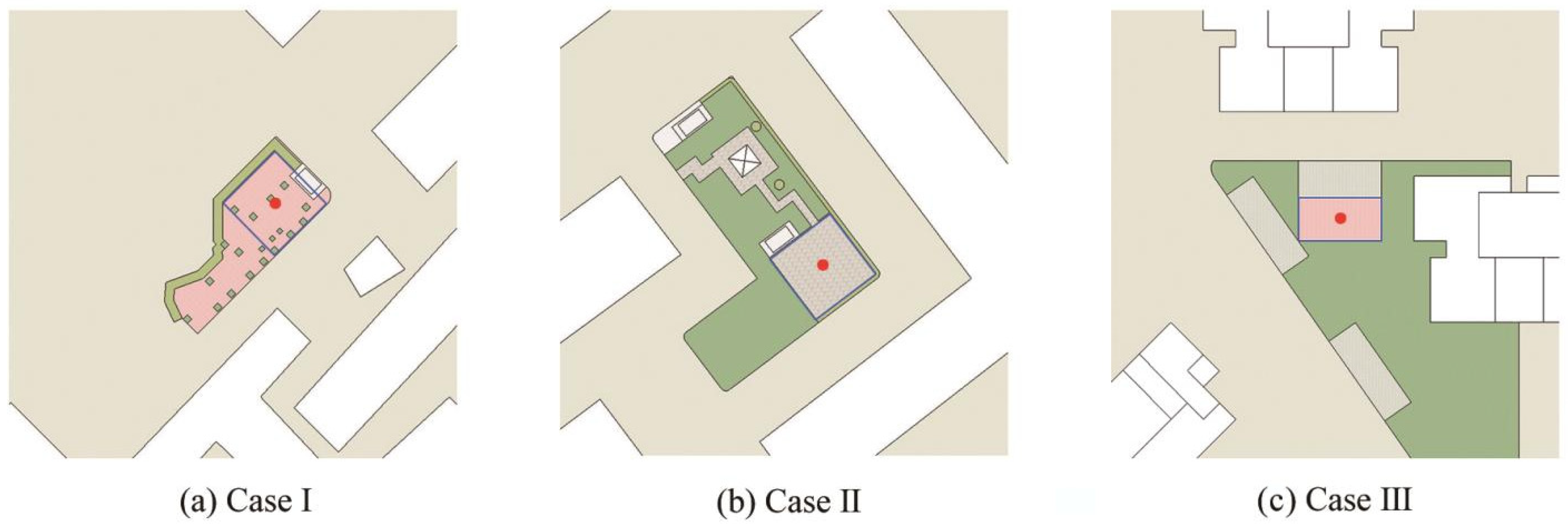
| Author | Location (Climate Types) | Space Type | Conclusion |
|---|---|---|---|
| Kwon C W, Lee K J. [25] | London, Manchester, Glasgow, the UK (Temperate marine climate) | Fixed canopies | When 0% transparency canopy is provided, south orientation has the highest annual frequency of thermal comfort, followed by east orientation. |
| Ali-Toudert F, Mayer H. [40] | Ghardaia, Algerian Sahara (Subtropical desert climate) | Galleries | The north-oriented and south-oriented galleries remain uncomfortable for shorter time in comparison to those facing in east and west directions. |
| Yin S, Lang W, Xiao Y, et al. [41] | Guangzhou, China (Subtropical monsoon climate) | Semi-open arcades | E-W streets with arcades have better thermal conditions for pedestrians, the discomfort at peak times of air temperature in the arcades along N–S streets is an avoidless phenomenon. |
| Chan A L S. [42] | Netherlands (Temperate marine climate) | Open balconies | The installation of open balconies for these east-facing flats can save the most air conditioning energy consumption annually, the west-facing flats with balconies come second. |
| Rodríguez-Algeciras J, Tablada A, Nouri A S, et al. [38] | Barcelona, Spanish (Mediterranean climatic) | Open balconies | At the same height, balconies on the south and southeast façade achieve the highest frequencies of thermal comfort. The second best settings are the east-oriented balconies, while the north-oriented balconies show the least favourable thermal conditions. |
| Andreou E. [37] | Island of Tinos, Greece (Mediterranean climatic) | Covered street | Covered streets show the best thermal comfort conditions for all orientations, followed by the north-oriented sidewalk along E–W streets. |
| Yin S, Lang W, Xiao Y, et al. [43] | Guangzhou, China (Subtropical monsoon climate) | Arcades | The cooling efficiency of NS-oriented streets with arcades is approximately four times that of EW-oriented arcade streets. |
| Sözen İ, Oral G K. [33] | Mardin, Turkey (Mediterranean climatic) | Galleries | South-oriented semi-open gallery spaces achieve lowest PET values so that provide the highest outdoor thermal comfort conditions during all hours, and is followed by east orientation with the second-best cooling effects, the west-oriented such spaces are the least comfortable. |
| Author | Location (Climate Types) | Space Type | Conclusion |
|---|---|---|---|
| Ali-Toudert F, Mayer H. [40] | Ghardaia, Algerian Sahara (Subtropical desert climate) | Galleries | The discomfort increases with wider streets and higher galleries, but the galleries along E–W oriented streets remains almost not affected by the aspect ratio, so the northward and southward galleries are an appropriate strategy for wider streets. |
| Su Y M, Chang H T. [47] | Tai wan, China (Subtropical monsoon climate) | Arcades | In subtropical climates, arcades with a lower aspect ratio of 0.75 are more advantageous to enhance comfort level of pedestrians than higher aspect ratio. |
| Savvides A, Michael A, Malaktou E, et al. [46] | Maroni, Pera Orinis, Askas, Cyprus (Subtropical Mediterranean climate) | Covered passages | High aspect ratio and the consequent small sky exposure decrease additional shading effects of covered passages for streets, so covered passages are more effective in small aspect ratio streets. Furthermore, covered passages are unable to incur additional shading due to the low sun-angle altitude in winter. |
| Yin S, Lang W, Xiao Y, et al. [41] | Guangzhou, China (Subtropical monsoon climate) | Arcades | Reducing the aspect ratio of arcade achieves better pedestrian thermal comfort, but the effect of such strategy seems limited for EW-oriented street. |
| Juan Y H, Wen C Y, Li Z, et al. [35] | Tai wan, China (Subtropical monsoon climate) | Overhead floor | A half-open space with a lower aspect ratio improves the capacity of ventilation on the pedestrian pathway layer. |
| Hang J, Luo Z, Sandberg M, et al. [48] | Guangzhou, China (Subtropical monsoon climate) | Covered streets | Street roofs setting at differing heights effects differently on natural ventilation of urban canopy layers, covered streets with a lower aspect ratio will weaken the ventilation performance. |
| Kim T, Kim K, Kim B S. [49] | Seoul, Korea (Temperate monsoon climate) | Arcades | The air-exchange rate is changed according to the arcade roof height. Lower arcade roof intercepts larger amount of the inflowing air that may cause the overheating and bad ventilation effect. |
| Weng J, Luo B, Xiang H, et al. [44] | Chongqing, China (Subtropical monsoon climate) | Overhead floor | Comfortable environmental state is negatively correlated to the overhead height, heightening the overhead floors can stimulate ventilation, it will also bring in more solar radiation and then deteriorates thermal comfort of space. |
| Yin S, Xiao Y. [50] | Guangzhou, China (Subtropical monsoon climate) | Verandah | In the south of China, a more comfortable microclimate will be conducted with the aspect ratio of verandah at less than 1. Under the circumstances, both the peak and the average PET value are lower in streets for different orientations. |
| Author | Location (Climate Types) | Space Type | Conclusion |
|---|---|---|---|
| Malaktou E, Philokyprou M. [51] | Nicosia, Cyprus (Subtropical Mediterranean climate) | Arcades | Whether hot spell days or normal summer days, the central area of arcade reduces the frequency and duration of heat stress compared to the edge. |
| Omrani S, Garcia-Hansen V, Capra B R, et al. [53] | Brisbane, Australia (Subtropical area influenced by continental climate) | Open balconies | In most cases, an open balcony is able to increase the indoor average velocity and improve the ventilation performance compared to a semi-enclosed balcony, even in the most unfavourable prevailing wind direction (90°). |
| Yuan X, Ryu Y, Sekartaji D. [56] | Kitakyushu, Japan (Subtropical monsoon humid climate) | Open balconies | For warm climate regions, south-facing enclosed balconies have a more positive impact on the indoor thermal environment in winter, and even uninsulated enclosed balconies can achieve higher heat gains and better energy efficiency than open balconies with insulation. |
| Weng J, Luo B, Xiang H, et al. [44] | Chongqing, China (Subtropical monsoon climate) | Overhead ground floor of buildings | Ta and wind velocity is positively related to the openness degree of the overhead floor, For RH, the reverse is true. An openness degree of 0.75–0.5 achieves the relative optimum thermal comfort for both cases. The opposite-two-sided enclosure position of the overhead area is the most favourable for thermal comfort, low openness will cause accumulation of heat and moisture. |
| Munawaroh A S, Damayanti E, Prasetyo Y A. [54] | Lampung, Indonesia (Tropical rainforest climate) | Semi-outdoor canteen | Thermal sensation is closer to neutral in semi-outdoor spaces without a wall than in that with a wall, omitting wall improves the air velocity and dissipates heat. |
| Yilmaz S, Külekçi E A, Mutlu B E, et al. [55] | Erzurum, Turkey (Temperate continental climate) | Canopies | Due to the lack of wind movement, the full-covered pedestrian road traps heat that leads to higher ambient temperature, which is a positive point for the winter months but will be disadvantageous in summer because of heat stress risk. So semi-open, semi-closed canopy system is more suitable for walkable pedestrian-friendly street designs. |
| The Location of the Investigated Residential Area | The Spatial Extent of Outdoor Activity Space | Environment Characters of Measured Spaces | |
|---|---|---|---|
| Cases I | 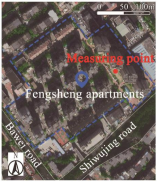 | 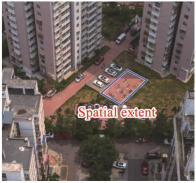 | Location: The corner of the L-shaped apartment building. Plant structure: Arbor-shrub-grass Paving: Impermeable red brick |
| Cases II | 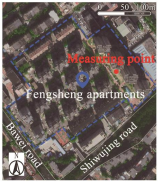 |  | Location: Between the staggered pattern of apartment buildings Plant structure: Arbor-shrub Paving: Impermeable red brick and gray brick interlaced oblique laid |
| Cases III | 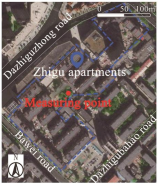 | 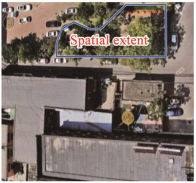 | Location: Between two rows of apartment buildings Plant structure: No plants Paving: Impermeable red brick |
| Micrometeorological Parameter | Measuring Instrument | Measuring Range | Accuracy | Resolution |
|---|---|---|---|---|
| Air temperature | TR-74Ui-H | −30–80 °C | ±0.3 °C (0–50 °C) ±0.5 °C (all other temperatures) | 0.1 °C |
| Globe temperature | AZ-8778 | 0–50 °C | ±0.6 °C | 0.1 °C |
| Relative humidity | TR-74Ui-H | 10–95%RH | ±2.5%RH (at 25 °C, 10 to 85%RH) ±4.0%RH (at 25 °C, 0 to 10% or 85 to 99%RH) | 0.1%RH |
| Wind speed | Testo 425 | 0.0–10.0 m/s | ±(0.1 m/s + 5%rdg) | 0.01 m/s |
| Season | Numerical Value | Air Temperature Ta/°C | Global Temperature Tg/°C | Relative Humidity RH/% | Wind Speed m/s |
|---|---|---|---|---|---|
| Summer | Average value | 31.9 | 33.8 | 28 | 1.2 |
| Maximum value | 36.6 | 41.2 | 67 | 3.6 | |
| Minimum value | 26.2 | 24.7 | 47 | 0.1 | |
| Difference | 10.4 | 16.5 | 20 | 2.5 | |
| Winter | Average value | 3.2 | 5.8 | 38 | 2.4 |
| Maximum value | 6.3 | 12.2 | 55 | 5.8 | |
| Minimum value | −3.2 | 1.3 | 13 | 0.1 | |
| Difference | 9.5 | 10.9 | 42 | 5.7 |
| Season | Climatic Parameters | Summer (18 August) | Winter (31 January) |
|---|---|---|---|
| Summer | Maximum temperature | 34 °C | 4 °C |
| Minimum temperature | 26 °C | 1 °C | |
| Maximum Relative humidity | 21.2% | 28% | |
| Minimum relative humidity | 15.4% | 11% | |
| winter | Mean wind speed | 1.2 m/s | 2.2 m/s |
| Wind direction | 118° | 38° | |
| Cloud amount | 0 | 0 |
| Physical Parameter | Date | Case I | Case II | Case III |
|---|---|---|---|---|
| Daliy Incident Solar Radiation | Aug. 15th | 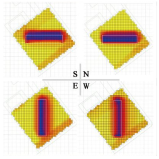 |  | 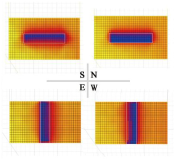 |
Jan. 31st | 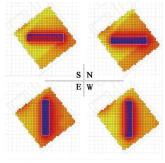 | 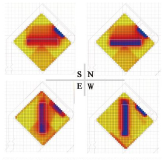 | 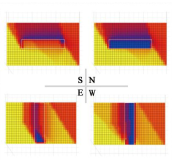 | |
| Daliy Sunlight Hours | Aug. 15th | 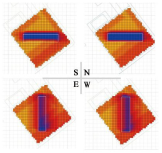 | 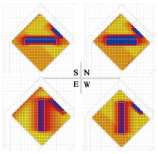 | 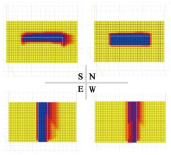 |
Jan. 31st | 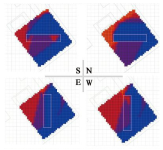 | 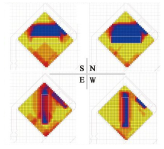 | 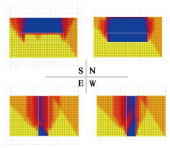 | |
| Daliy Wind Speed and Direction | Aug. 15th | 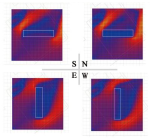 | 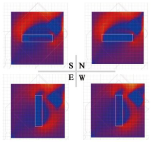 | 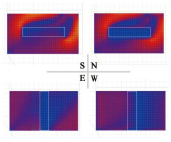 |
Jan. 31st | 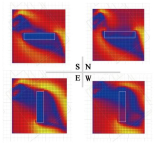 | 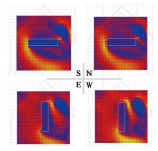 | 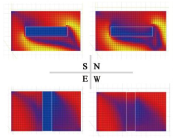 |
| Physical Parameter | Date | Case I | Case II | Case III |
|---|---|---|---|---|
| Daliy Incident Solar Radiation | Aug. 15th |  | 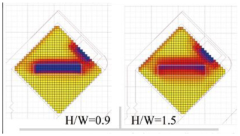 | 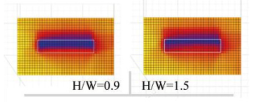 |
Jan. 31st | 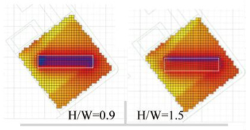 | 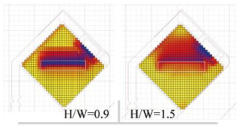 |  | |
| Daliy Sunlight Hours | Aug. 15th | 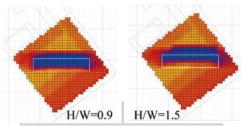 | 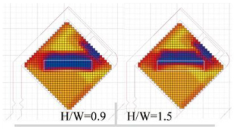 |  |
Jan. 31st |  | 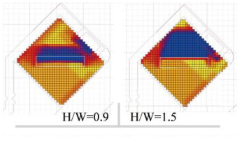 | 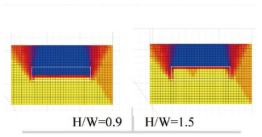 | |
| Daliy Wind Speed and Direction | Aug. 15th | 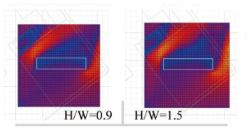 | 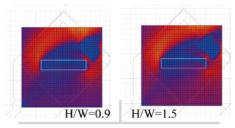 | 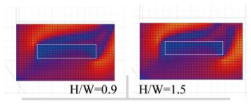 |
Jan. 31st | 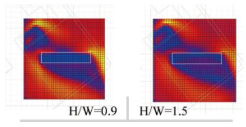 | 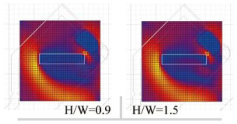 | 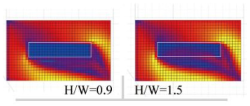 |
| Physical Parameter | Date | Case I | Case II | Case III |
|---|---|---|---|---|
| Daliy Incident Solar Radiation | Aug. 15th | 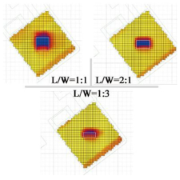 |  | 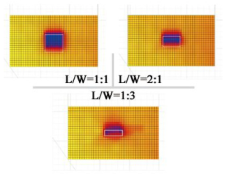 |
Jan. 31st | 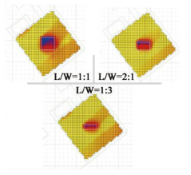 | 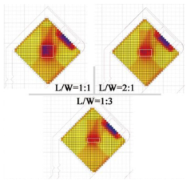 | 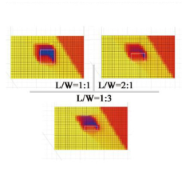 | |
| Daliy Sunlight Hours | Aug. 15th | 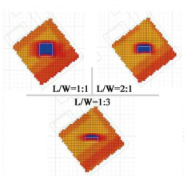 | 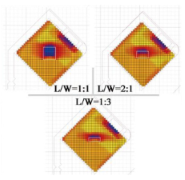 | 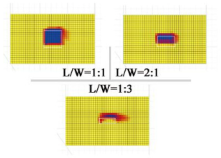 |
Jan. 31st | 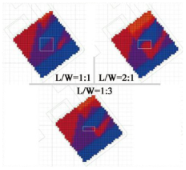 |  | 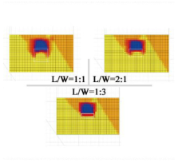 | |
| Daliy Wind Speed and Direction | Aug. 15th | 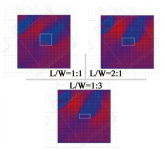 | 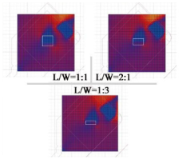 | 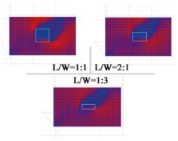 |
Jan. 31st |  | 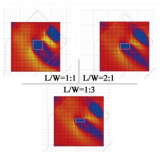 | 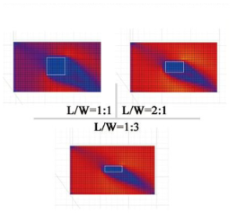 |
| Physical Parameter | Date | Case I | Case II | Case III |
|---|---|---|---|---|
| Daliy Incident Solar Radiation | Aug. 15th |  | 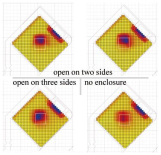 |  |
Jan. 31st | 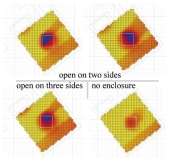 | 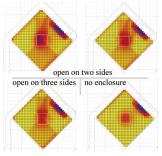 | 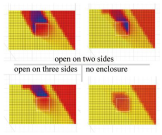 | |
| Daliy Sunlight Hours | Aug. 15th | 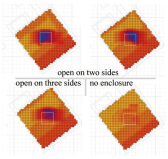 |  |  |
Jan. 31st | 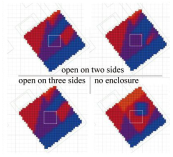 | 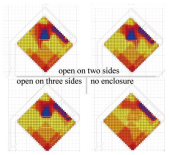 | 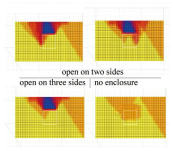 | |
| Daliy Wind Speed and Direction | Aug. 15th |  | 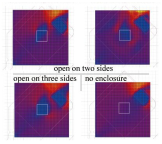 | 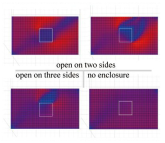 |
Jan. 31st | 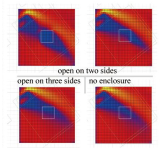 | 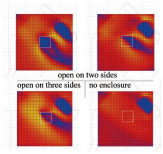 | 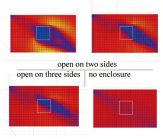 |
Disclaimer/Publisher’s Note: The statements, opinions and data contained in all publications are solely those of the individual author(s) and contributor(s) and not of MDPI and/or the editor(s). MDPI and/or the editor(s) disclaim responsibility for any injury to people or property resulting from any ideas, methods, instructions or products referred to in the content. |
© 2025 by the authors. Licensee MDPI, Basel, Switzerland. This article is an open access article distributed under the terms and conditions of the Creative Commons Attribution (CC BY) license (https://creativecommons.org/licenses/by/4.0/).
Share and Cite
Hou, G.; Kuai, Y.; Shu, P.; Li, X.; Wei, S. Research on the Design Parameters of Outdoor Transitional Spaces Based on the Improvement of Thermal Environment. Buildings 2025, 15, 3808. https://doi.org/10.3390/buildings15213808
Hou G, Kuai Y, Shu P, Li X, Wei S. Research on the Design Parameters of Outdoor Transitional Spaces Based on the Improvement of Thermal Environment. Buildings. 2025; 15(21):3808. https://doi.org/10.3390/buildings15213808
Chicago/Turabian StyleHou, Guoying, Yiming Kuai, Ping Shu, Xuan Li, and Shen Wei. 2025. "Research on the Design Parameters of Outdoor Transitional Spaces Based on the Improvement of Thermal Environment" Buildings 15, no. 21: 3808. https://doi.org/10.3390/buildings15213808
APA StyleHou, G., Kuai, Y., Shu, P., Li, X., & Wei, S. (2025). Research on the Design Parameters of Outdoor Transitional Spaces Based on the Improvement of Thermal Environment. Buildings, 15(21), 3808. https://doi.org/10.3390/buildings15213808






